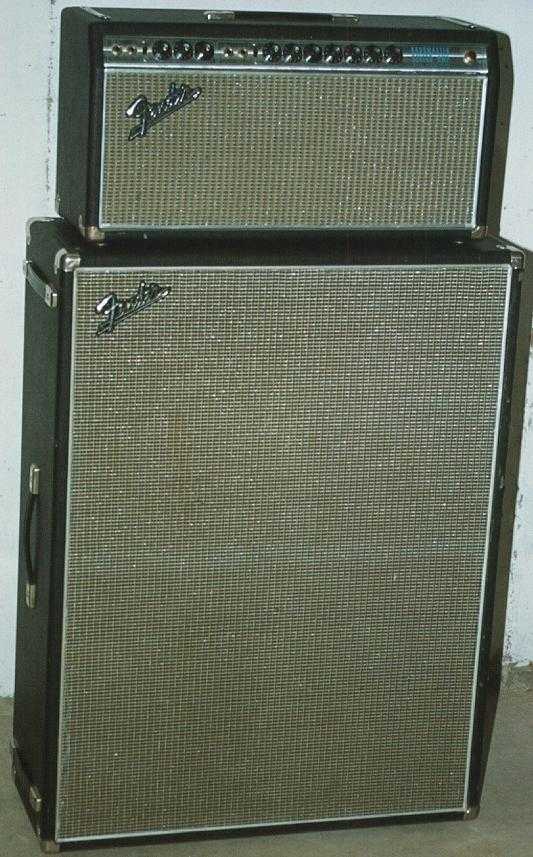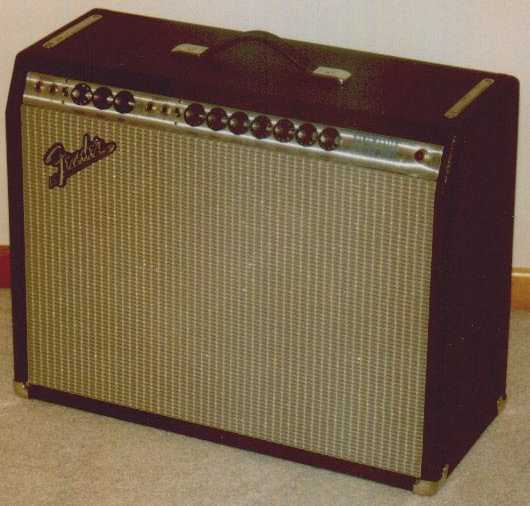Project Vibroclone
by Greg Gagliano
Copyright 1996, 20th
Century Guitar Magazine.
Do you want a blackface Fender Vibroverb, but can’t afford one?
Do you really like that early SRV tone? Well, here’s a nifty project
that you can do to create a Vibroclone from an existing Fender amp.
But first, the usual caveats. Don’t mess with a tube amp if you don’t
know what you’re doing. They store enough voltage to kill you even
when they are not plugged in and, of course, they are even more dangerous
when they are plugged in. If you want a Vibroclone, but you don’t do
amps, then have a competent amp tech do it for you. Now on to the nitty
gritty...

I started out with a 1968 Bandmaster Reverb TFL5005D, but you can use any
Fender reverb amp that uses two 6L6GC power tubes such as a Super, Vibrolux
or Pro. The TFL5005D sounded nice, but with its extra large cabinet
and head it was bigger than what I wanted or needed in a guitar amp.
Internet amp tech guru, John Stokes, suggested that the Bandmaster Reverb
could be made into a Vibroverb clone and gave me the details of how he created
one from a 1970 Bandmaster Reverb (AA270, also the TFL5005D). I found
this very appealing as I would end up with a 1x15" combo amp (my favorite
configuration) that would be easy to transport and that would have great tone.
The Bandmaster Reverb head has the added feature of a Midrange control on
the reverb channel, which the original 1964 Vibroverb did not have.
I needed an open-back cabinet to house the chassis and a 15 inch speaker.
John had Tom Bremer of Bremer Music make him a custom cab that was similar
to the original 1x15 Vibroverb’s dimensions. Since this was a custom
job, John specified that the cab be covered in blonde tolex with Oxblood
grille (his personal favorite vintage Fender cosmetics). To complete
the retro look he had a repro blackface control plate made (with Fender nomenclature
conspicuously absent for legal reasons). I chose not to go the custom
route. I found a 1970 Fender Bantam Bass amp which uses a cabinet that
is identical to the Super Reverb right down to the tilt back legs. The
TFL5005D chassis has the same dimensions as a Super Reverb and would fit
perfectly into the Bantam cab. Bantam Bass amps aren’t exactly sought
after for their thundering bass tone, so I thought it would be a good donor
for a cab and the chassis could be used for a future project. The Bantam
cab, while larger than John’s custom cab, would still provide for a reasonably
light and portable amp.
A new baffleboard for a 15 inch speaker was needed since the stock Bantam
Bass baffle was cut for the funky trapezoidal Yamaha speaker. Gregg
Hopkins at Vintage Amp Restoration made a baffleboard and covered it with
blue sparkle grill cloth so as to match the silverface cosmetics of the
chassis. Gregg’s attention to detail on something as simple as a baffleboard
was astounding. It is accurate right down to the black grill cloth
staples placed on an angle using the same spacing as found on late 1960s
Fender amps.
There are several excellent 15 inch guitar speakers available for a project
of this type, including those made by JBL, Altec, Jensen, and Eminence.
Since he was using his Vibroclone for gigging, John chose to use a JBL D130F
for it’s superior low end response, power handling capability, and efficiency.
JBLs can be a little brittle on the high end due to the aluminum dome and
John found a great way around this problem. He took a blown D130F and
had it custom reconed using an edge wound kaptan voice coil (instead of paper)
and an all paper cone (no aluminum dome). John reports that this configuration
yields all the “oomph” typical of JBLs without the brittleness up top.
I was not planning on gigging with my amp (I’m a bassist), so I opted for
a Jensen C15N. This is an excellent sounding efficient speaker that
would perform well at lower “household” volumes.
Now that I had the chassis, cabinet and speaker ready, I assembled all
the pieces, fired her up, and put her through the paces using a G&L
Legacy. The amp sounded good and the open-back, 15" speaker cab’s tone
was completely different compared to the stock, closed-back, 2x12 Bandmaster
Reverb cabinet. The sound was punchy with well-balanced response between
bass and treble. It was also loud and stayed clean up to 4 on the volume
control. Now, it’s important to note here that the stock output transformer
impedance is 4 ohms and I was running into an 8 ohm speaker. Not ideal,
but it wouldn’t fry anything either since Fenders are tolerant of an impedance
mismatch of 100 percent or less. I could have stopped my Vibroclone
project at this point, but I felt that it lacked some depth to its tone so
I yanked the chassis and proceeded to tinker some more. However, I
suspect that many people would like the amp’s sound at this stage of the
project.
I performed a blackface conversion on the bias supply and phase inverter
portions of the circuit. John had been urging me to do this right
from the start of the project. This was the first thing he did with
his Vibroclone and he touted the virtues of its tone. The 1968 TFL5005D
(AA668) circuit is identical to the AB568 Super Reverb so it was easy enough
to convert it to blackface following the AB763 Super Reverb schematic.
Re-biasing was all that was necessary after the face lift.
I also installed an 8 ohm output transformer as John did on his amp.
The stock output transformer is the same part used on the Pro Reverb and
Vibrolux Reverb. It’s not bad, but it lacks a substantial iron core.
John suggested that I could use an aftermarket 8 ohm transformer (as he did,
obtained from Bremer Music) or a Twin Reverb transformer. I opted for
a Twin Reverb replacement part from Nate Kramer at Mojo Musical Supply, which
was heavier and larger than the stock unit, and less expensive than an original
Twin tranny. John explained that the Twin output transformer, when used
in a two power tube amp, wants to see an 8 ohm load rather the 4 ohm load
as it would in a four power tube amp. This replacement transformer bolted
right to the chassis without a hitch and the wires were even color coded
the same as the stock unit making installation a breeze.
Time to bolt everything back together and play it again. This baby
cranks!! The tone is much more complex and rich with lots of depth and
clarity. The amp is much more sensitive to touch on the guitar which
makes it very expressive. It’s also louder with more punch. It
stays very clean to 3 on the volume control, then begins to get that bluesy
growl at 3 ½ and by 4 it’s going into a creamy overdrive. Going
above 4 is too loud for household use and at these higher levels, the Jensen
starts to get flabby. That’s the advantage to using the JBL at higher
volumes - it can take it. John reports that, during gigs, his Vibroclone
easily keeps up with his bandmate’s blackface 1965 Super Reverb. That
certainly says a lot for this amp!
I wanted to fine tune my Vibroclone further, if possible, so I began
to swap different tubes in and out of the amp. John chose NOS (new old
stock) preamp, 5AR4 rectifier, and GE 7581 power tubes. While the earliest
TFL5005 model used a 5AR4 rectifier, the later TFL5005s used a 5U4GB.
Note that John switched to a 5AR4 for more headroom and tighter sound.
I kept the stock 5AR4 rectifier and settled on NOS 12AX7 and 12AT7 preamp
tubes as these sounded excellent to me. A very close second choice would
have been Sovtek 12AX7WXTs. These are very economical and are pretty
quiet, but they sounded a bit brittle compared to the NOS tubes.
For power tubes, I started with the original RCA 6L6GCs which produced
sweet tones, but they were clearly a little tired. I tried a pair
of NOS Sylvania 6L6GCs instead. These had much more pep than the 28
year old RCAs, but were a little harsh. Next up were a fresh matched
pair of Sovtek 5881WXTs. The 5881s were very smooth and did not exhibit
any high end harshness that was present with the Sylvania 6L6GCs.
Finally, I tried a matched pair of NOS Phillips 7581s which are a heavy
duty industrial version of the 6L6GC. Another quick re-bias and the
amp performed very well. There seemed to be more power on tap then
there was with either the 6L6GCs or the 5881s. The 7581s gave
more punch to the bass frequencies, but like the 6L6GCs, they were a little
harsh.
I would have been satisfied with any of these power tubes since the amp’s
tone was clean and loud with each type. In the final analysis, I opted
for the 7581s because I liked the extra kick they gave, but the 5881WXTs were
a close and very economical second choice. John believes that the best
tone would be obtained by using fresh NOS RCA “Blackplate” 6L6GCs, but those
are becoming nearly impossible to find.

So there you have it. A 1x15 combo amp with classic Fender tone (think
early SRV), reverb and tremolo for about 25 to 35 percent of the cost of a
real 1x15 Vibroverb. The Vibroclone serves as a very nice jazz amp as
well and easily keeps up with classic 1x15 tube jazz amps such as the Ampeg
Gemini II. I would like to thank fellow Fender amp fanatic, Greg Huntington,
for his help with some of the technical aspects of this project.
About the Author: Greg Gagliano, a ravenous researcher of Fender
amp serial number data, can be contacted c/o TCG. John Stokes can be
contacted by e-mail at tremolux@aol.com.
Nate Kramer of Mojo Musical Supply can be contacted by e-mail at mojo@mojotone.com. Gregg Hopkins can
be contacted by e-mail at vintageamp@aol.com.
Back to GGJaguar's
Bibliography

